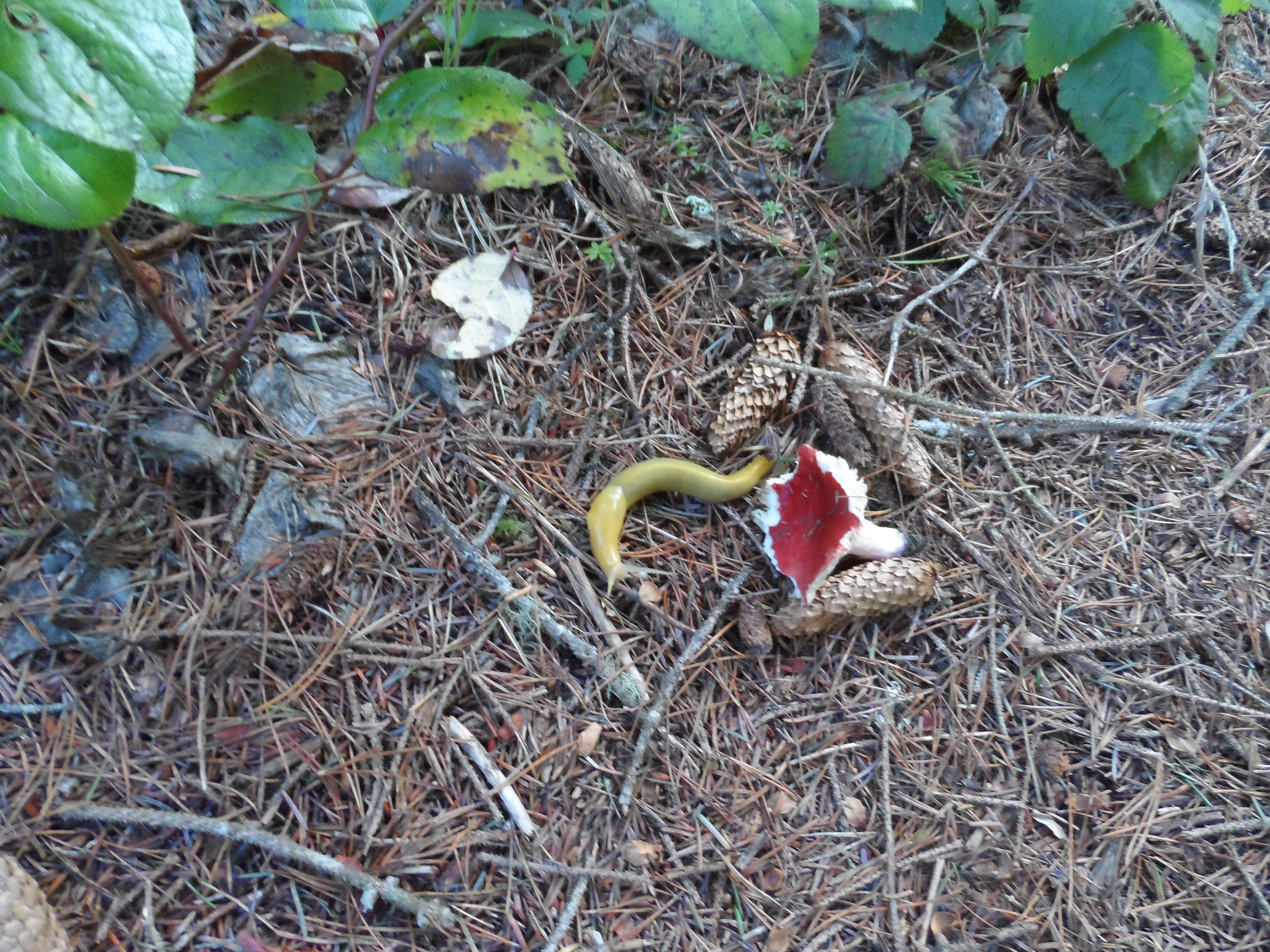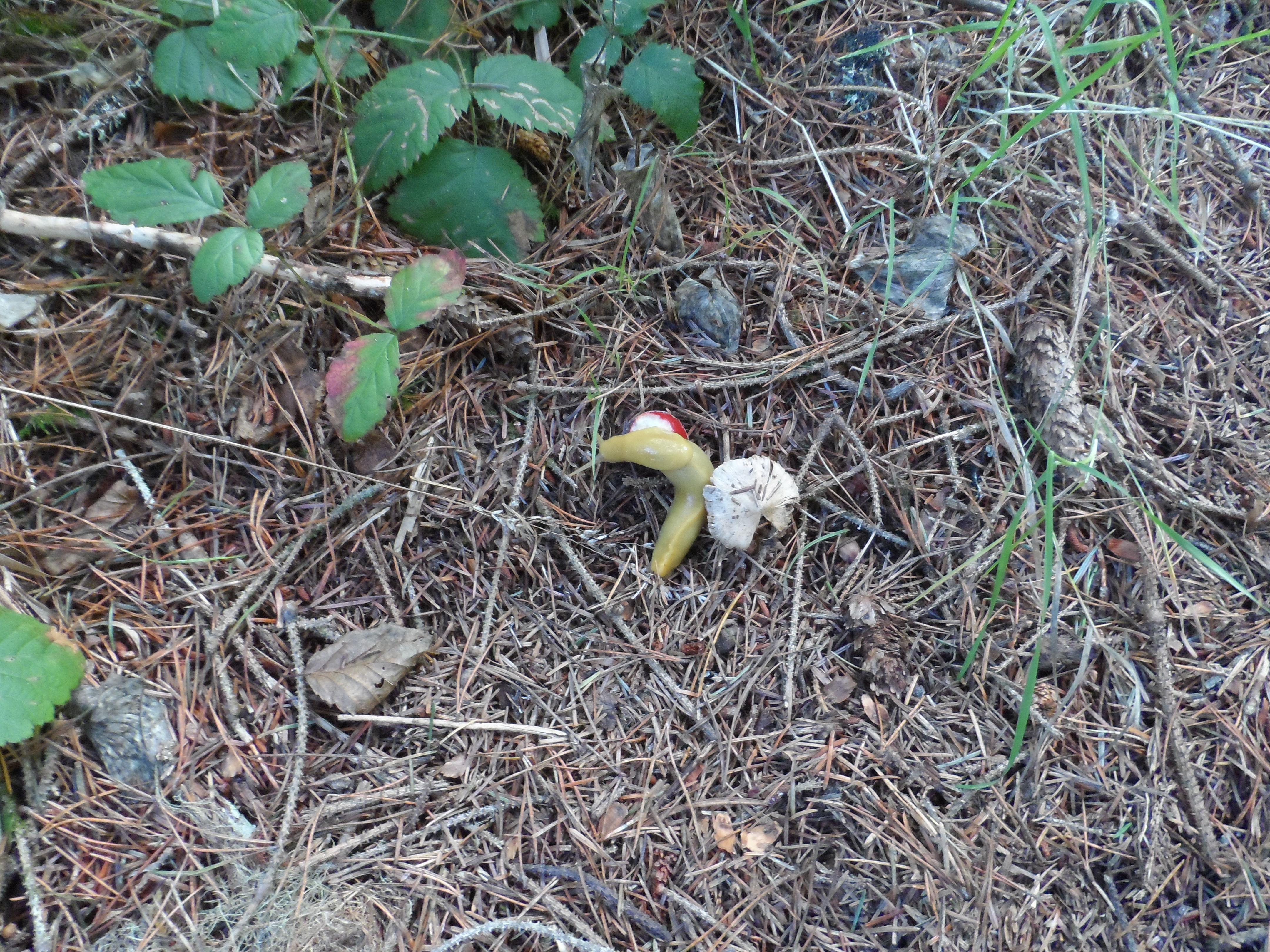Banana Slugs and Oregon Mushrooms
Here are two of the neat things you can find while out tromping in the forests of Oregon. The first neat thing you will see plenty of – are mushrooms – all kinds of mushrooms. The second is a slightly rarer creature, but still plentiful – the banana slug! We came across a banana slug interacting with a mushroom and took a couple of photos…
Banana Slug Eats Oregon Mushroom
A Bit About Banana Slugs
Not surprising to anyone who has seen this gastropod (a shell-less mollusk), the banana slug is named for its bright yellow color and large size. Some banana slugs have black spots and sometimes, they are found to be greenish, brown, tan, or white. These variations in color maybe due to its diet and the amount of moisture in the environment. The banana slug is the common name for three North American species of terrestrial slug in the genus Ariolimax. The Pacific banana slug is the second-largest species of terrestrial slug in the world and the largest in North America. It can grow to the length of 25 centimeters (about 10 inches).
The banana slug is very well adapted to the redwood and Pacific Coast forest environment, ranging between Santa Cruz, California and Alaska. They are at home among the coastal redwoods, Douglas firs and Sitka spruces and appreciate dark damp places. When it’s hot and bright, banana slugs are more likely to burrow under some fallen leaves and rest, waiting for cooler, damper weather to return. They are often found foraging for food once night falls. The slugs are an important part of a balanced eco-system, because the banana slugs are native and provide a useful waste management purpose in the local environment.
Banana slugs are detritivores, or decomposers – they feed on and break down dead plant or animal matter. If they crawl through some animal feces, for example, banana slugs are likely to stop for a quick meal. The slugs munch on lichen and mushrooms – they are basically known as the “clean-up crew” for the forest floor. And unlike some slugs, you do not have to worry about them invading your garden and nibbling on strawberries or tomatoes. Younger (smaller) banana slugs are, in turn, often eaten by shrews or moles. Banana Slugs are also hunted by birds, raccoons, and such species as the Pacific Giant Salamander and Northwestern Garter Snake.
And as far as human consumption goes – this gastropod has been used as food by Yurok Indians of the North Coast and by German immigrants in the 19th and early 20th centuries.
Banana slugs are covered with a slime that serves many purposes and have a muscular foot for locomotion. The banana slug is able to retract both pairs of tentacles to protect them from the surrounding environment. Banana slugs have a single lung which opens externally via a pneumostome – a breathing hole in the right side of the mantle (top of body). And like most slugs, the banana slug is hermaphroditic, ie, containing both female and male organs.
When a banana slug is ready to reproduce it puts a chemical in its slime that attracts a mate to it, with the desire to choose a partner of equal size. The penis of a full-grown banana slug is easy to see, while it is on… One distinctive behavior of the banana slug is how its penis maybe gnawed off when disengaging from intercourse – a process called “apophallation”. But Nature is clever, although the individual slug may have lost its the penis, it is still able to mate using only the female parts of the reproductive system.
Our friend, the banana slug, is the mascot of the University of California at Santa Cruz! UCSC’s athletic director, Linda Spradley, said the recognition of the mascot will raise national awareness about UCSC sports–and believes the Banana Slug is a fitting symbol for the entire campus. “The Banana Slug is indigenous to our area, it’s prolific here, and it speaks to the entire campus – not just athletics,” said Spradley.
While not well-known, banana slugs are able to climb down from tree branches by hanging off thin strands of their slime and that is a sight to see.
Another fun fact about the banana slug is that each one can have up to 27,000 very small teeth on its tongue! A banana slug can live for up to seven years.
=> News and Video About Banana Slugs Below
Related Books
See this TITLE: Pug the Banana Slug Pirate
 |
Banana slugs can become pirates! A point Pug attempts to prove, setting out from his home in the redwoods for a swashbuckling adventure. On his way, he encounters many local characters, plus learns a fair bit about banana slugs.
See this TITLE: Hiking the Redwood Coast: Best Hikes Along Northern And Central California’s Coastline (Regional Hiking Series)
 |
Hiking the Redwood Coast is a trail guide covering all of the best hikes along California’s central and northern coastlines. In addition to detailed directional cues, hike stats, and local information, the book provides comprehensive trail descriptions and GPS-quality, digitally designed route maps for each hike.



Comments
Banana Slugs and Oregon Mushrooms — No Comments
HTML tags allowed in your comment: <a href="" title=""> <abbr title=""> <acronym title=""> <b> <blockquote cite=""> <cite> <code> <del datetime=""> <em> <i> <q cite=""> <s> <strike> <strong>